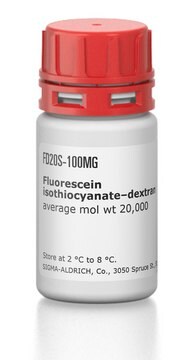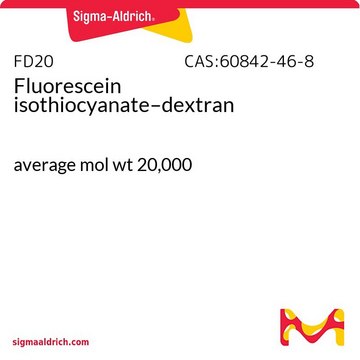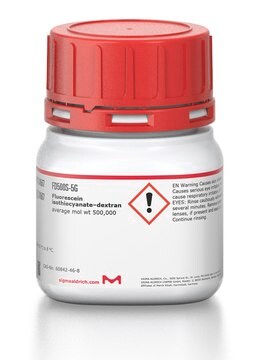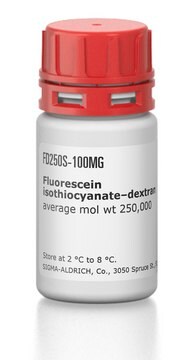FD40S
Fluorescein isothiocyanate–dextran
average mol wt 40,000
Synonym(s):
FITC–Dextran
Sign Into View Organizational & Contract Pricing
All Photos(3)
About This Item
Recommended Products
biological source
synthetic (organic)
conjugate
FITC conjugate
form
powder
mol wt
average mol wt 40,000
extent of labeling
0.003-0.020 mol FITC per mol glucose
color
yellow to dark orange
solubility
H2O: soluble 25 mg/mL, clear to slightly hazy, yellow to deep orange
storage temp.
2-8°C
Looking for similar products? Visit Product Comparison Guide
General description
Dextran is a polymer of anhydroglucose. It is composed of approximately 95% α-D-(166) linkages. The remaining (163) linkages account for the branching of dextran. Native dextran has been found to have a molecular weight (MW) in the range of 9 million to 500 million. FITC-dextran has an excitation maximum of 490 nm. It has a pH range of 5 to 9.
Application
Dextran labeled with fluorescein isothiocyanate for possible use in perfusion studies in animals.
Fluorescein isothiocyanate–dextran (FITC-dextran, fluorescein-dextran, FITC) was used in the following processes:
- Fluorescein-dextran microscopy.
- To evaluate the in vivo pulmonary vascular permeability in polymorphonuclear leukocyte α-defensins expressing transgenic mice.
- To quantify endocytic activity by flow cytometry.
- To label α-lactalbumin and ribonuclease.
Linkage
Similar to FD-40, but produced by Sigma.
Preparation Note
Sigma typically tests the solubility of FITC dextrans in water at concentrations at or above 25 mg/ml. Solutions should be protected from light. In vivo, FITC-dextran is stable for more than 24 hours.
Other Notes
Native dextran has been found to have a molecular weight (MW) in the range of 9 million to 500 million. Lower MW dextrans will exhibit slightly less branching and have a more narrow range of MW distribution. Dextrans with MW greater than 10,000 behave as if they are highly branched. As the MW increases, dextran molecules attain greater symmetry. Dextrans with MW of 2,000 to 10,000, exhibit the properties of an expandable coil. At MW below 2,000, dextran is more rod-like. The MW of dextran is measured by one or more of the following methods: low angle laser light scattering, size exclusion chromatography, copper-complexation and anthrone reagent colorometric reducing-end sugar determination and viscosity.
To gain a comprehensive understanding of our extensive range of Dextrans for your research, we encourage you to visit our Carbohydrates Category page.
Signal Word
Warning
Hazard Statements
Precautionary Statements
Hazard Classifications
Eye Irrit. 2 - Skin Irrit. 2 - STOT SE 3
Target Organs
Respiratory system
Storage Class Code
11 - Combustible Solids
WGK
WGK 3
Flash Point(F)
Not applicable
Flash Point(C)
Not applicable
Personal Protective Equipment
dust mask type N95 (US), Eyeshields, Gloves
Choose from one of the most recent versions:
Already Own This Product?
Find documentation for the products that you have recently purchased in the Document Library.
Customers Also Viewed
Yun Mi Lee et al.
Journal of diabetes research, 2013, 245271-245271 (2013-12-29)
Retinal pathogenic angiogenesis in the eyes is a causative factor in retinopathy of prematurity, diabetic retinopathy, and age-related macular degeneration. This study was designed to examine the pathogenic role of the high-mobility group box-1 (HMGB1) protein and the inhibitory effect
The structure of NRRL B-512F dextran, methylation studies.
Van Cleve JW, Schacfer WC and Rist CE
Journal of the American Chemical Society, 4435-4438 null
Erika M J Siren et al.
Scientific reports, 8(1), 7581-7581 (2018-05-17)
Here we present a simple technique for re-directing reactions on the cell surface to the outermost region of the glycocalyx. Macromolecular crowding with inert polymers was utilized to reversibly alter the accessibility of glycocalyx proteoglycans toward cell-surface reactive probes allowing
Molecular weight, molecular-weight distribution and molecular size of native dextran.
AROND L H and H P FRANK
The Journal of Physical Chemistry, 953 - 957 (1954)
Yun Mi Lee et al.
BMC complementary and alternative medicine, 15, 271-271 (2015-08-13)
Retinal neovascularization is a common cause of vision loss in proliferative diabetic retinopathy, retinopathy of prematurity and age-related macular degeneration. Samul-tang (SMT) is a widely used traditional herbal medicine in East Asia and is also known as Shimotsu-to in Japanese
Our team of scientists has experience in all areas of research including Life Science, Material Science, Chemical Synthesis, Chromatography, Analytical and many others.
Contact Technical Service










